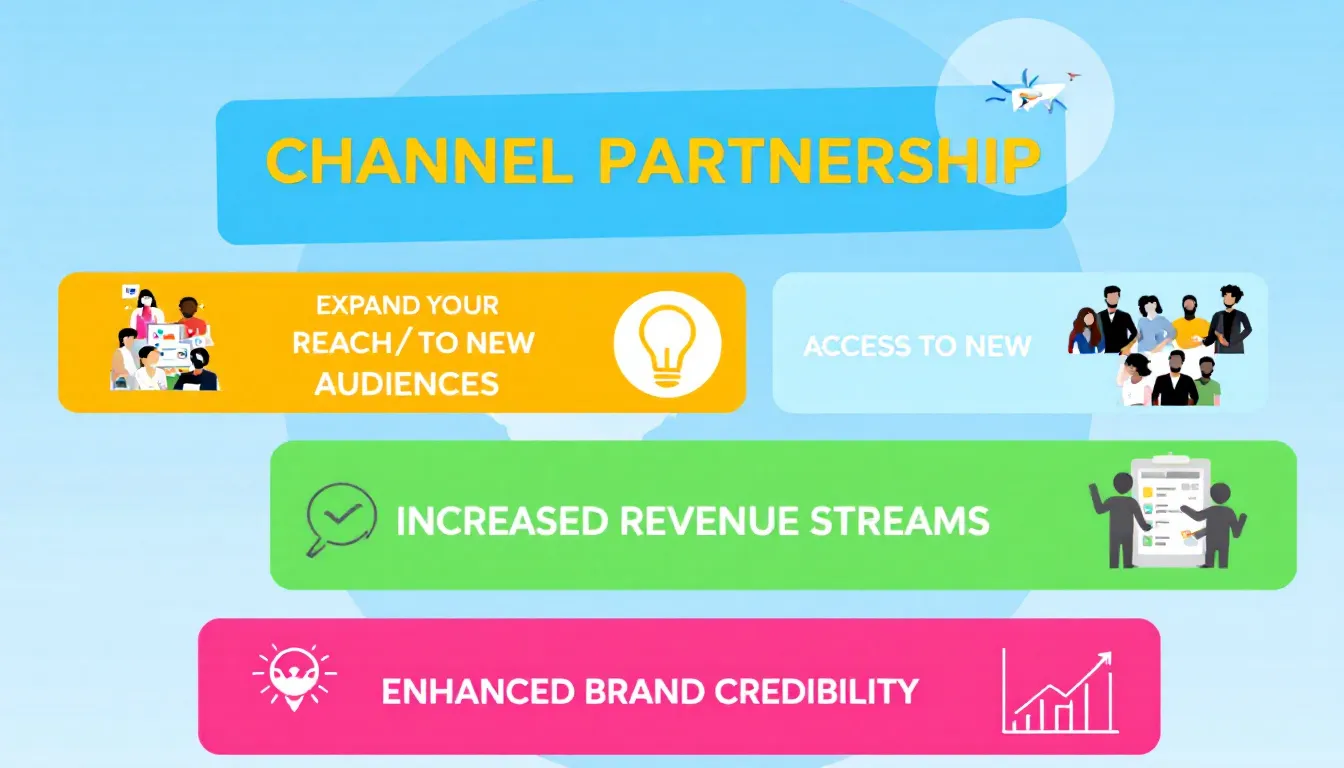If you’re looking to grow faster without hiring an army of sales reps, channel partners might be your best move. Done right, they can open doors to new markets, drive steady revenue, and extend your brand without ballooning your headcount.
But “channel partner” isn’t just another buzzword. It’s a real strategy that, when executed well, can scale your business efficiently.
In this guide, we’ll break down what a channel partner actually is, the different types you’ll run into, and how they help you grow. No fluff—just the essentials you need to understand how channel partnerships work and how to use them to your advantage.
So, What Are Channel Partners?

A channel partner is a company or individual that helps you sell your product—without being on your payroll. Think of them as an extension of your sales and success teams. They generate leads, close deals, support customers, and in some cases, even implement your product.
They don’t just resell. The best channel partners bring market expertise, trusted relationships, and local insight you don’t have. They’ve already built credibility with your target customers—and they use that trust to open doors you might not reach on your own, enhancing your channel sales strategy.
In B2B companies, channel partners might handle:
- Lead gen and qualification
- Sales prospecting and demos
- Deal closing and procurement
- Implementation or onboarding
- Ongoing support or success
This setup lets you scale faster without building a huge sales org. You focus on your product and core GTM motion. They help you expand into new markets, verticals, or regions with less friction.
Bottom line: good partners don’t just sell for you—they help you win new logos, reduce CAC, and grow revenue with lower overhead.
Types of Channel Partners (and How They Help You Grow)
Not all channel partners play the same role. Understanding the different types of channel partnerships is crucial, as some help you sell, some help you scale, and others help you reach audiences you can’t get to on your own. So, what are all the types of saas reseller types?
Here are the key types — and when to bring them in.
Referral Partners
Referral partners introduce potential customers to your sales team but don’t participate in the sales process itself. They might be consultants, freelancers, former clients, or even influencers within your industry. Their value lies in warm introductions, not deal execution. You pay them a referral fee if the deal closes—simple, low-risk, and low-maintenance.
Best for: Early-stage SaaS companies exploring partner sales without heavy enablement or infrastructure needs.
Resellers / VARs (Value-Added Resellers)
Resellers actively sell and close deals for your product. They may also bundle it with related services like implementation, local support, or compliance packages. Often embedded in a specific region or niche, they operate as an extension of your sales team—only they’re on the ground, with built-in relationships and credibility. Expect to invest in enablement and sales tools.
Best for: Expanding into new markets or verticals where you lack internal reach or expertise.
Implementation Partners
These partners don’t sell your product—they make sure customers succeed after the sale. They handle onboarding, customization, integrations, and sometimes long-term support. They’re often consultants or agencies with deep domain expertise. While they don’t directly generate revenue, they increase retention, improve time-to-value, and reduce churn risk by delivering a great customer experience.
Best for: Mid-to-enterprise SaaS products that require technical configuration, onboarding, or complex deployment.
Technology Partners
Technology partners integrate their solution with yours to create added value for both products. These relationships are often driven by API compatibility and mutual customer needs. Some lead to co-selling opportunities, while others simply enhance your product’s ecosystem. These partners are crucial when building a platform play or embedding your SaaS in a broader tech stack.
Best for: SaaS businesses with a developer-friendly product and ambitions to build or join a product ecosystem.
Affiliate Partners
Affiliates promote your product through content—blogs, newsletters, YouTube videos, and more—and earn a commission for each referred sale. They don’t handle demos or close deals. Affiliate marketing is a great top-of-funnel strategy to increase visibility at scale. These programs are often automated and low-touch, with partners leveraging your brand in their own channels.
Best for: Low-touch SaaS products targeting individual users or SMBs through high-volume digital marketing.
OEM / White Label Partners
OEM (Original Equipment Manufacturer) or white label partners resell your SaaS under their own brand, usually embedding it in their own offerings. You stay behind the scenes while they handle branding, customer relationships, and pricing. This model requires a stable, API-friendly product but opens the door to rapid scale through established vendors.
Best for: Mature SaaS platforms that prioritize large-scale distribution over direct brand recognition.
The Benefits of Channel Partnerships

For B2B companies—especially those in SaaS or services—business growth channel partnerships are one of the most efficient ways to scale revenue, reach new markets, and build brand trust without overextending your team. Instead of hiring dozens of reps or building region-specific go-to-market campaigns from scratch, a well-aligned partner can help you plug into established customer relationships and local expertise almost instantly.
Whether you’re targeting new verticals, entering a new region, or simply trying to expand pipeline without inflating CAC, partners give you leverage. They already have the trust of your ideal customers. They know the buying signals. And they often have service lines or value-adds that complement your product—making it easier to deliver outcomes, not just features.
For SaaS companies, the value is even more pronounced. In a subscription-based model, your growth depends not just on new logos, but on long-term adoption, retention, and customer success. Partners can play a critical role across the full lifecycle—from referral to sale to implementation and beyond. And in B2B, where sales cycles are long and relationships matter, the partner’s existing credibility can often make or break the deal.
Channel partnerships aren’t a silver bullet. But when done right, they become a strategic engine for sustainable growth.
Here’s what that looks like in practice:
1. Market Expansion Without Extra Headcount
Partners give you instant access to customers you’d otherwise have to spend months or years building relationships with, allowing you to gain access to a significant customer base and distribution network.
2. Faster Time to Revenue
They already know the accounts and the personas. That means shorter sales cycles, warmer intros, higher conversion rates, and more efficient sales efforts through strategic partnerships.
3. Local Insight, Global Reach
Partners bring cultural fluency, industry context, and on-the-ground insight that can’t be replicated from HQ. By leveraging their existing customer base, businesses can expand market reach and drive growth through these established relationships.
4. Leaner Operations
They handle sales, onboarding, and even ongoing support—freeing up your team and reducing cost-to-serve by minimizing the need for significant upfront investments.
5. Built-In Trust and Brand Amplification
Being recommended by a trusted advisor with a proven track record carries weight. It opens doors and builds credibility faster than any ad campaign.
In short: great partners don’t just help you sell—they help you scale smarter, reach further, and serve customers better. That’s the real value of a channel program that works.
How to Find the Right Channel Partners (Not Just More of Them)
Not all partners are good partners—and chasing volume over fit is one of the fastest ways to waste time and budget. The key to a successful channel strategy isn’t signing up dozens of logos; it’s finding the few who actually align with your business, your customers, and your go-to-market motion.
For B2B and SaaS companies, that means getting clear on what makes a partner valuable before you start recruiting. What kind of customers do they serve? Are they already trusted advisors in your industry or target vertical? Do they offer complementary services or products? Have they successfully sold or implemented solutions like yours before?
Start by defining your Ideal Partner Profile (IPP)—just like you would with an Ideal Customer Profile. Look at traits like:
- Industry expertise
- Go-to-market alignment
- Customer overlap
- Reputation and track record
- Willingness to invest in enablement
Once you know who you’re looking for, here are a few proven ways to find them:
- Industry directories and association networks – Tap into formal partner databases or curated listings from vertical-specific trade groups.
- Conferences and B2B events – Events are one of the best places to meet potential partners face-to-face and assess fit quickly.
- Warm referrals from existing partners or customers – The best introductions often come from people already in your ecosystem.
- Channel recruitment firms – If you’re serious about scaling quickly, experienced recruiters can help source, screen, and qualify the right candidates.
This isn’t about casting a wide net. It’s about building a high-leverage network of partners who are aligned, capable, and motivated to grow with you. Get that part right, and everything downstream—from onboarding to revenue—gets a lot easier.
Establishing Successful Channel Partner Relationships

Establishing strong channel partner relationships isn’t just about signing a contract and sending over a logo kit. It requires structure, consistency, and real investment from both sides.
The most effective partnerships start with mutual alignment—clear goals, shared metrics, and a plan for how both companies will win. That means agreeing on sales targets, KPIs, revenue share, and the roles each team will play in getting there.
But alignment on paper isn’t enough. Consistent communication is what keeps a partnership healthy over time. Regular check-ins, transparent updates, and open feedback loops ensure both sides stay in sync.
When issues surface, they’re resolved quickly. When wins happen, they’re shared and celebrated. Partner relationship management (PRM) tools can make this much easier to scale—centralizing deal registration, assets, support, and reporting in one place.
A solid onboarding process is also critical. If your partners don’t understand your product, your ideal customer, or how to sell alongside your team, they won’t ramp up. Enablement is not a one-and-done checklist—it’s an ongoing motion. Keep educating, sharing playbooks, and providing what they need to succeed.
Incentives matter too. The right rewards—financial and otherwise—drive behavior and deepen commitment. Recognizing top performers, offering co-marketing support, or giving early access to new products can all boost partner engagement. And don’t overlook joint marketing. Co-branded content, webinars, and campaigns build credibility with customers and signal a real partnership, not just a referral agreement.
Ultimately, successful channel relationships are built like any relationship—on trust, shared success, and regular communication. If your partners feel supported, valued, and clear on how to win with you, they’ll deliver. If not, they’ll drift.
Using Tech to Scale and Streamline Your Channel Program

Technology isn’t a nice-to-have in partner management—it’s foundational. As your channel grows, manual processes break down fast. Spreadsheets, scattered email threads, and guesswork around partner performance just don’t cut it. To scale effectively and make the most of your partner ecosystem, you need systems that support visibility, automation, and consistency.
Partner Relationship Management (PRM) platforms are the backbone here. They centralize key partner functions like onboarding, deal registration, lead tracking, training, and performance reporting. A good PRM gives both you and your partners a shared system of record, so no one’s operating in the dark. It also makes collaboration easier by giving partners self-serve access to enablement resources, co-marketing materials, and support, including managed service providers who offer specialized support in various industry sectors.
But it’s not just about running operations. The best channel partner programs are data-driven. That means using analytics tools to track not just revenue, but also partner-sourced leads, influenced deals, certifications completed, and content engagement. These KPIs help you understand what’s working, where partners are getting stuck, and how to optimize your strategy in real time. Without data, you’re flying blind.
Modern partner tech also supports more dynamic selling models. For example, referral partner platforms can automate how you track, credit, and compensate influence-based deals—crucial for B2B and SaaS companies where the sale may not flow directly through the partner. And as buyer journeys become more complex, tools like Impartner or Crossbeam help surface attribution data and identify partner overlap in your pipeline, creating more opportunities for strategic plays.
Bottom line: if you want to grow your partner program without losing control or visibility, you need the right tools. PRM platforms, analytics, and referral management systems aren’t just admin helpers—they’re what make scalable, high-performing channel strategies possible.
Overcoming Common Challenges in Channel Partnerships
Channel partnerships are not without their challenges. Common issues include misaligned goals, poor communication, and competition among partners or with direct sales teams. Addressing these challenges requires a proactive approach and a willingness to compromise when objectives are misaligned.
Regularly reviewing and realigning goals can ensure that both parties remain aligned and focused on common objectives. Encouraging open dialogue and feedback channels can improve communication with partners, reducing misunderstandings and inefficiencies. Ongoing support practices such as regular check-ins, use of partner portals, and clear protocols can enhance communication and collaboration.
Managing partner conflicts can involve defining territories, implementing a fair deal registration process, and creating partnership tiers to ensure fairness and transparency. Conflicts concerning pricing may arise, requiring transparent communication to maintain relationships. A robust deal registration process ensures fairness among competing partners and can mitigate conflicts. Additionally, referral partners who refer potential customers can play a crucial role in expanding the customer base and enhancing sales.
Regular audits of channel programs can help identify performance issues and enhance partner engagement. Developing engaging partner programs with attractive incentives can also boost partner engagement and showcase the value of the partnership. Addressing these common challenges fosters stronger, more effective channel partnerships.
Case Studies of Successful Channel Partnerships

Real-world examples can provide valuable insights into how channel partnerships can drive business success. One notable case is Mace Group, which increased its client base by 200% after implementing accessplanit for streamlined training administration. This partnership not only enhanced their operational efficiency but also significantly expanded their market reach.
Another example is BERNINA, which improved its training efficiency for retail staff by customizing mobile training programs in collaboration with CD2 Learning. This allowed BERNINA to better educate its retail partners and provide comprehensive training, leading to improved sales performance and customer satisfaction through specialized expertise and the latest industry trends.
Five Guys also leveraged channel partnerships to enhance its operations. By selecting Schoox to improve training reporting, Five Guys was able to enhance compliance with its corporate franchise structure. This partnership ensured that all franchisees received consistent and effective training, contributing to the overall success of the brand.
HubSpot’s famous partner program faced internal resistance in its early days. HubSpot was initially a direct-sales driven startup, and when an employee first pushed the idea of selling through marketing agency partners, the executive team was skeptical (even the CEO doubted it). It took internal evangelizing and proof of concept – a few early partner-driven sales successes – to convince leadership. Once they saw the potential (those partners eventually drove 40% of revenue), they got fully behind it. HubSpot then scaled an entire channel organization to support agencies.
Microsoft’s partner ecosystem became legendary because Microsoft engineered profitability for partners. By ensuring that for every dollar Microsoft made, partners could make multiple dollars in services or add-ons, they gave partners a huge incentive to throw their weight behind Microsoft’s products.
These examples illustrate how strategically leveraging channel partnerships and technology partnerships can lead to substantial growth and operational improvements. Collaborating with the right partners enables businesses to unlock new opportunities and achieve their growth objectives more efficiently. In particular, the healthcare industry benefits significantly from such partnerships, as they enable the integration of specialized technology solutions tailored to its unique challenges, thereby enhancing service delivery and improving operational efficiency.
Summary
Channel partnerships are a powerful strategy for businesses looking to expand their market reach, increase sales, and enhance brand reputation. By understanding what channel partners are, collaborating with technology providers, and the different types available, businesses can develop a comprehensive channel strategy that aligns with their goals.
The benefits of channel partnerships are numerous, including increased market share, revenue growth, scalability, and improved operational efficiency. Identifying the right partners, establishing successful relationships, and leveraging technology are crucial steps in maximizing the potential of these partnerships.
In conclusion, channel partnerships offer a pathway to sustainable growth and competitive advantage. By fostering mutually beneficial relationships and addressing common challenges, businesses can unlock new avenues for expansion and achieve long-term success.
Embrace the power of channel partnerships and watch your business soar to new heights.
Frequently Asked Questions
What are channel partner?
A channel partner is essentially a business or person that works with another company to market and sell its products or services. They help out with everything from generating leads to providing customer support for the company’s products.
What are the types of channel partners?
The main types of channel partners are resellers, distributors, and affiliate partners, each contributing uniquely to the sales and distribution process. Reseller partners, in particular, sell a vendor’s products with minimal modifications, leveraging their market expertise to enhance product sales and expand market reach. Understanding these roles can help you streamline your business strategy effectively.
How do I identify the right channel partner?
To identify the right channel partner, focus on finding someone with the right industry expertise, target market alignment, and shared values. Don’t forget to check their track record and reputation in the specific market segment to ensure a good fit for your business.
What are the benefits of channel partnerships?
Channel partnerships boost your market share and revenue while enhancing operational efficiency and brand reputation. Plus, they give you valuable insights into the market, improve customer satisfaction, and help attract new customers.
How can technology aid in managing channel partners?
Technology can significantly simplify managing channel partners by utilizing tools like Partner Relationship Management (PRM) systems and analytics. A software company can leverage these resources to track performance, improve collaboration, and fine-tune sales strategies for better results.